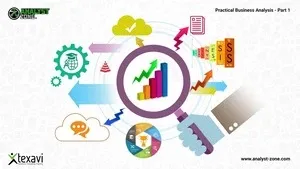This plan includes
- Limited free courses access
- Play & Pause Course Videos
- Video Recorded Lectures
- Learn on Mobile/PC/Tablet
- Quizzes and Real Projects
- Lifetime Course Certificate
- Email & Chat Support
What you'll learn?
- Identify and assess potential risks to the organization
- Develop strategies to mitigate or manage identified risks
- Monitor and report on risk management activities
- Understand the role of governance and compliance in risk management
- Use the risk management process in your ongoing decision-making processes
- Gain the know-how to establish a framework for managing risk in your company
- Understand the role of culture in risk management.
- Understand the role of technology in risk management
- The different types of risks that organizations face, including but not limited to financial, operational, strategic, compliance and reputational risks
- The use of risk management frameworks, such as ISO 31000 or COSO, and how to apply them to an organization
- Techniques for assessing and measuring risks, including quantitative and qualitative methods
- The use of risk management tools and techniques, such as risk mapping, scenario planning, and risk financing
- The role of risk management in strategic planning and decision-making
- The role of internal controls and audit in risk management
Course Overview
An enterprise risk management course typically provides students with an in-depth understanding of the concepts, tools, and techniques used to identify, assess, and manage risks to an organization's capital and earnings. The course may cover topics such as:
-
Different types of risks, including financial, operational, strategic, compliance, and reputational risks
-
Risk management frameworks, such as ISO 31000 or COSO, and how to apply them to an organization
-
Techniques for assessing and measuring risks, including quantitative and qualitative methods
-
Risk management tools and techniques, such as risk mapping, scenario planning,
-
If you're looking for a course to understand the architecture of risk management based on the newest ISO 31000 standard (2018), this is the course you are looking for.
-
If you're looking to be practical: to study the tools in assessing the risks, you might have to look for ISO 31010 or other materials to enhance your understanding.
-
Learn how to motivate your employees/colleagues to manage risk on their own without constant prodding, cajoling, and reminders.
-
Bolster your image as an authoritative, confident decision-maker by managing risk instead of letting it manage you!
-
Earn a certificate from Udemy upon course completion and use it in a LinkedIn post.
This course is backed by a 30-day refund policy. If you're not completely satisfied, simply request a refund through your dashboard.
Pre-requisites
- No prerequisite requirement
- Enterprise risk management courses are typically designed for students and professionals in business and finance-related fields.
- Some prior coursework in risk management
- A basic understanding of business concepts
- Business professionals looking to expand their knowledge and skills in risk management
Target Audience
- anyone with an interest in understanding how to identify, assess, and manage risks to an organization's capital and earnings
- Enterprise risk management courses are typically designed for students and professionals in business and finance-related fields.
- Management professionals, such as general managers, operations managers, and project managers
- Compliance professionals
- Entrepreneurs and small business owners who want to learn how to identify and manage risks in their business
- Government and non-profit organization staffs who want to understand how to identify and manage risks in their organization
- Professionals from other industries such as healthcare, construction, and manufacturing, who want to understand how to identify and manage risks in their respective industries.
Curriculum 202 Lectures
Section 1 : Course Overview
- Lecture 2 :
- Tips to Improve Your Course Taking
Section 2 : 1- What is Risk
- Lecture 1 :
- 1-Definition of Risk
- Lecture 2 :
- 2-Uncertainty and Its Relationship to Risk
- Lecture 3 :
- 3-Differences between HAZARD vs. RISK Vs. Perils Vs HARM
- Lecture 4 :
- 4-Differences between ISSUE VS. RISK
- Lecture 5 :
- 6-Risk Base Thinking
Section 3 : 2-Risk Management
- Lecture 1 :
- 1-Risk Management
- Lecture 2 :
- 2-Risk Management Process
- Lecture 3 :
- 3-Risk Management Applications
- Lecture 4 :
- 4-Risk Management Tenets and Principle
- Lecture 5 :
- 5-Risk Management Fundamentals
- Lecture 6 :
- 6-Risk Management Importance
- Lecture 7 :
- 7- Signs of Poor Risk Mangment
Section 4 : 3-Enterprise Risk Management (ERM)
- Lecture 1 :
- 1-Enterprise Risk Management (ERM)
- Lecture 2 :
- 2-Approaches to ERM
- Lecture 3 :
- 3-Traditional ERM
- Lecture 4 :
- 4-ERM Fundamental Concepts
- Lecture 5 :
- 5-ERM Categories
- Lecture 6 :
- 6-ERM Framework Components
- Lecture 7 :
- 7-ERM Advantages
- Lecture 8 :
- 8-ERM Disadvantages
- Lecture 9 :
- 9-ERM Implementation Guide
- Lecture 10 :
- 10-ERM Implementation Challenges
Section 5 : 4-ERM Roles and Responsibilities
- Lecture 1 :
- 1-ERM Roles and Responsibilities
- Lecture 2 :
- 2-Board of Directors
- Lecture 3 :
- 3-Board of Trustees Audit Committee
- Lecture 4 :
- 4-CEO (Chief Executive Officer)
- Lecture 5 :
- 5-Chief Risk Officer (CRO)
- Lecture 6 :
- 6-Chief audit officer
- Lecture 7 :
- 7-ERM Advisory Committee (ERMAC)
- Lecture 8 :
- 8-ERM Risk Manager
- Lecture 9 :
- 9-auditor
- Lecture 10 :
- 10-Department Heads role
- Lecture 11 :
- 11-Individual Employee
Section 6 : 5- EMR framework Types
- Lecture 1 :
- 1-EMR framework Types
- Lecture 2 :
- 2-Casualty Actuarial Society ERM
- Lecture 3 :
- 3-The COSO ERM Integrated Framework
- Lecture 4 :
- 4-ISO 31000 ERM Framework
- Lecture 5 :
- 5-ISO 31000 vs COSO
- Lecture 6 :
- 6-COBIT ERM Framework
- Lecture 7 :
- 7-COSO Vs COBIT Frameworks
- Lecture 8 :
- 8-NIST ERM Framework
- Lecture 9 :
- 9-RIMS Risk Maturity Model
- Lecture 10 :
- 10-Deloitte Legal ERM Framework
Section 7 : 6-Custom ERM Frameworks
- Lecture 1 :
- 1-Custom ERM Frameworks
- Lecture 2 :
- 2-Custom ERM consideration
- Lecture 3 :
- 3- Custom ERM Process
- Lecture 4 :
- 4-Stage one Build a Cross-Functional ERM Team
- Lecture 5 :
- 5-Stage Two Identify Risk
- Lecture 6 :
- 6-Stage Three Establish Risk Assessment Methodology
- Lecture 7 :
- 7-Stage Four Treat and optimize risk
- Lecture 8 :
- 8-Stage Five Optimize Risk Management
Section 8 : 7-How to Implement Enterprise Risk Management
- Lecture 1 :
- 1-How to Implement
- Lecture 2 :
- 2-Step One Develop ERM Foundation
- Lecture 3 :
- 3-Step Two stakeholders
- Lecture 4 :
- 4-Step Three Identify RISK
- Lecture 5 :
- 5-Step Four Risk Treatment
- Lecture 6 :
- 6-Step Five Risk Optimization
Section 9 : 8-ERM Framework Elements
- Lecture 1 :
- 1-Risk Appetite
- Lecture 2 :
- 2-Risk Appetite Statements (RAS)
- Lecture 3 :
- 3-Risk Tolerance
- Lecture 4 :
- 4-Risk Attitude
- Lecture 5 :
- 5-Residual Risk
- Lecture 6 :
- 6-Risk Reporting Dashboards
- Lecture 7 :
- 7-RISK CAPACITY
- Lecture 8 :
- 8-RISK TARGET
- Lecture 9 :
- 9-RISK LIMIT
- Lecture 10 :
- 10-Risk level
- Lecture 11 :
- 11-RISK CRITERIA
- Lecture 12 :
- 12-RISK EVALUATION
- Lecture 13 :
- 13-RISK Prioritization
- Lecture 14 :
- 14-Risk Response
- Lecture 15 :
- 15-Risk Data Analytics
- Lecture 16 :
- 16-Portfolio Risk Management
- Lecture 17 :
- 17-Risk Management Plan
- Lecture 18 :
- 18-Risk maturity
- Lecture 19 :
- 19-Risk perception
- Lecture 20 :
- 20-Risk magnitude
- Lecture 21 :
- 21-Risk significance
- Lecture 22 :
- 22-Risk Modeling
- Lecture 23 :
- 23-Risk Governance
Section 10 : 9-Integrated Risk Management
- Lecture 1 :
- 1-Integrated Risk Management
- Lecture 2 :
- 2-Integrated Risk Management Attributes
- Lecture 3 :
- 3-Integrated Risk Management Benefits
- Lecture 4 :
- 4-Integrated Risk Management Steps
- Lecture 5 :
- 5-Integrated Risk Management Challenges
- Lecture 6 :
- 6-Governance Risk and Compliance
Section 11 : 10-ISO 31000 -2018 RISK Management
- Lecture 1 :
- 1-ISO 31000 -2018 RISK Management
- Lecture 2 :
- 2-ISO 31000 RISK Management Principles
- Lecture 3 :
- 3-ISO 31000 RISK Management Framework
- Lecture 4 :
- 4-Leadership and commitment
- Lecture 5 :
- 5-Integration
- Lecture 6 :
- 6-Design
- Lecture 7 :
- 7-Implementation
- Lecture 8 :
- 8-Evaluation
- Lecture 9 :
- 9-Improvement
- Lecture 10 :
- 10-ISO RISK Management process
Section 12 : 11-ISO Scope, context and criteria
- Lecture 1 :
- 1-Scope, context and criteria
- Lecture 2 :
- 2-Establish Organization Context
- Lecture 3 :
- 3-Internal and External context
- Lecture 4 :
- 4-Internal and External tools
- Lecture 5 :
- 5-SWOT Analysis
- Lecture 6 :
- 6-PESTEL PEST Analysis
- Lecture 7 :
- 7-MOST analysis
- Lecture 8 :
- 8-Porter’s five force model
- Lecture 9 :
- 9- SCRS analysis
- Lecture 10 :
- 10-VPEC-T analysis
- Lecture 11 :
- 11-Heptalysis model
- Lecture 12 :
- 12-De Bono’s Six Thinking Hat
- Lecture 13 :
- 13-Catwoe
- Lecture 14 :
- 14-Five whys
- Lecture 15 :
- 15-MoSCow
Section 13 : 12-ISO Communication and Consultation
- Lecture 1 :
- 1-Communication and Consultation
- Lecture 2 :
- 1-Forms of RISK Communication
- Lecture 3 :
- 2-Communication plan
- Lecture 4 :
- 3-Obtain Organizational Support
- Lecture 5 :
- 4-Perform a Situation Analysis
- Lecture 6 :
- 5-Identify and Define Objectives Goals
- Lecture 7 :
- 6-Understand and Profile Y
- Lecture 8 :
- 7-Form Communication Teams
- Lecture 9 :
- 8-Plan and design your message
- Lecture 10 :
- 9-Decide communication Channels
- Lecture 11 :
- 10-create an action plan
- Lecture 12 :
- 11-Create a Timetable for Publish
- Lecture 13 :
- 12-Monitor and Evaluate
Section 14 : 13-Risk Assessment
- Lecture 1 :
- 1-Risk Assessment
- Lecture 2 :
- 2-Approaches to risk assessment
- Lecture 3 :
- 3-Risk Assessment Types-part1
- Lecture 4 :
- 3-Risk Assessment Types-part2
- Lecture 5 :
- 4-Risk Assessment selection
- Lecture 6 :
- 5-Risk Assessments VS Method Statements
- Lecture 7 :
- 6-RAMS documents
- Lecture 8 :
- 7-Job Safety Analysis
Section 15 : 14-Risk identification
- Lecture 1 :
- 1-Risk Identification
- Lecture 2 :
- 2-Risk identification criteria
- Lecture 3 :
- 3-Risk Identification Life Cycle
- Lecture 4 :
- 4-Risk Categorization
- Lecture 5 :
- 5-Risk Identification Barriers
- Lecture 6 :
- 6-Risk Identification Mistakes
Section 16 : 15-Risk Assessment and Identification Techniques
- Lecture 1 :
- 1-Identification Techniques
- Lecture 2 :
- 2-Risk Interview
- Lecture 3 :
- 3-Brainstorming
- Lecture 4 :
- 4-Document Reviews
- Lecture 5 :
- 5-Assumption Analysis
- Lecture 6 :
- 6-Delphi Technique
- Lecture 7 :
- 7-Synectics
- Lecture 8 :
- 8-NGT
- Lecture 9 :
- 9-Affinity diagram
- Lecture 10 :
- 10-Monte Carlo Simulation
Section 17 : 16-Risk Analysis
- Lecture 1 :
- 1-Risk Analysis
- Lecture 2 :
- 2-Risk Analysis Benefits
- Lecture 3 :
- 3-Risk Analysis Principles
- Lecture 4 :
- 4-Risk Analysis Limitations
- Lecture 5 :
- 5-Qualitative Risk Analysis
- Lecture 6 :
- 6-Semi-Quantitative Risk Analysis (SQRA)
- Lecture 7 :
- 7-QUANTITATIVE Risk Analysis (QRA)
- Lecture 8 :
- 9-RISK IMPACT
- Lecture 9 :
- 8-Best risk analysis type
- Lecture 10 :
- 10-RISK Likelihood
Section 18 : 17-Risk Analysis Scales
- Lecture 1 :
- 1-Risk Analysis Tools
- Lecture 2 :
- 2-Risk Assessment Matrix
- Lecture 3 :
- 3-Likelihood scale
- Lecture 4 :
- 4-Consequence's Scale
- Lecture 5 :
- 5-Annual Loss Expectancy (ALE)
- Lecture 6 :
- 6- Risk Rating Scale
- Lecture 7 :
- 7-Control Effectiveness
- Lecture 8 :
- 8-Risk Priority Number, RPN
- Lecture 9 :
- 9-Risk Register
- Lecture 10 :
- 11-Risk Breakdown Structure
Section 19 : 18-Risk Evaluation and Control
- Lecture 1 :
- 1-Risk Evaluation
- Lecture 2 :
- 2-Risk Map
- Lecture 3 :
- 3-Risk control
- Lecture 4 :
- 4-Preventive controls
- Lecture 5 :
- 5-Corrective Controls
- Lecture 6 :
- 6-Directive controls
- Lecture 7 :
- 7-Detective controls
- Lecture 8 :
- 8-All In One
Section 20 : 19-Risk Treatment
- Lecture 1 :
- 1-Risk Treatment
- Lecture 2 :
- 1-Risk Controls VS Risk Treatments
- Lecture 3 :
- 2-Negative Vs Positive
- Lecture 4 :
- 3-Risk Acceptance response
- Lecture 5 :
- 4-Risk Treat response
- Lecture 6 :
- 5-Risk Transfer response
- Lecture 7 :
- 6-Risk Transfer - vs Risk Shifting
- Lecture 8 :
- 7-Risk Avoidance response
- Lecture 9 :
- 8-RISK Escalation response
- Lecture 10 :
- 9-RISK Exploit response
- Lecture 11 :
- 10-RISK Enhance response
- Lecture 12 :
- 11-RISK Share response
- Lecture 13 :
- 12-Risk Treatment Plans (RTP)
Section 21 : 20-RISK MONITORING & REVIEW
- Lecture 1 :
- 1-RISK MONITORING & REVIEW
- Lecture 2 :
- 2-MONITORING VS REVIEW
- Lecture 3 :
- 3-When to Review
- Lecture 4 :
- 4-Risk Monitoring Tools
- Lecture 5 :
- 5-Recording and Reporting Risk
- Lecture 6 :
- 6-Record and Report Risks Steps
- Lecture 7 :
- 7-effective reporting elements
Section 22 : 21-Risk culture
- Lecture 1 :
- 1-Risk Culture
- Lecture 2 :
- 2-Components of positive risk culture
- Lecture 3 :
- 4-Risk training and risk culture
- Lecture 4 :
- 5- Deloitte Risk Culture Framework
Our learners work at
Frequently Asked Questions
How do i access the course after purchase?
It's simple. When you sign up, you'll immediately have unlimited viewing of thousands of expert courses, paths to guide your learning, tools to measure your skills and hands-on resources like exercise files. There’s no limit on what you can learn and you can cancel at any time.Are these video based online self-learning courses?
Yes. All of the courses comes with online video based lectures created by certified instructors. Instructors have crafted these courses with a blend of high quality interactive videos, lectures, quizzes & real world projects to give you an indepth knowledge about the topic.Can i play & pause the course as per my convenience?
Yes absolutely & thats one of the advantage of self-paced courses. You can anytime pause or resume the course & come back & forth from one lecture to another lecture, play the videos mulitple times & so on.How do i contact the instructor for any doubts or questions?
Most of these courses have general questions & answers already covered within the course lectures. However, if you need any further help from the instructor, you can use the inbuilt Chat with Instructor option to send a message to an instructor & they will reply you within 24 hours. You can ask as many questions as you want.Do i need a pc to access the course or can i do it on mobile & tablet as well?
Brilliant question? Isn't it? You can access the courses on any device like PC, Mobile, Tablet & even on a smart tv. For mobile & a tablet you can download the Learnfly android or an iOS app. If mobile app is not available in your country, you can access the course directly by visting our website, its fully mobile friendly.Do i get any certificate for the courses?
Yes. Once you complete any course on our platform along with provided assessments by the instructor, you will be eligble to get certificate of course completion.
For how long can i access my course on the platform?
You require an active subscription to access courses on our platform. If your subscription is active, you can access any course on our platform with no restrictions.Is there any free trial?
Currently, we do not offer any free trial.Can i cancel anytime?
Yes, you can cancel your subscription at any time. Your subscription will auto-renew until you cancel, but why would you want to?
Instructor

6918 Course Views
5 Courses



 Tech & IT
Tech & IT
 Business
Business
 Coding & Developer
Coding & Developer
 Finance & Accounting
Finance & Accounting
 Academics
Academics
 Office Applications
Office Applications
 Art & Design
Art & Design
 Marketing
Marketing
 Health & Wellness
Health & Wellness
 Sounds & Music
Sounds & Music
 Lifestyle
Lifestyle
 Photography
Photography









-min.png?crop=smart&width=600&height=400)








